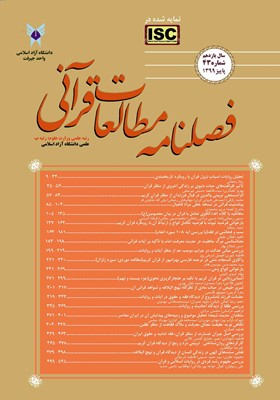بررسی طلقا از دیدگاه احادیث و روایات
محورهای موضوعی : فصلنامه مطالعات قرآنیابراهیم خراسانی 1 , محسن مرادی 2
1 - استادیار دانشگاه آزاد اسلامی واحد بافت
2 - دانشجوی دکتری دانشگاه آزاد اسلامی واحد بافت
کلید واژه:
چکیده مقاله :
پژوهش حاضر در صدد بررسی طلقا از دیدگاه احادیث و روایات است. از این منظر پس از بسط فضای مفهومی موضوع، به بررسی بحث طلقا خواهد پرداخت. مطابق با مستندات موضوعی ارائه شده در این پژوهش، روش تحقیق، توصیفی- تحلیلی و روش گردآوری اطلاعات در این پژوهش، کتابخانه ای می باشد.یافتههای تحقیق حکایت از آن دارند که اولاً طلقا به کسانی مانند ابوسفیان، معاویه و عموماً اهل مکه گفته میشود که پس از فتح مکه، مسلمان شدند و سپس رسول اکرم(ص) آنها را آزاد کرد، ثانیاً فتوحات ایران و اسلام عاملی شد بر نفوذ هرچه بیشتر گروه طلقا در سیاست و خلافت که گسترش این گروه پیامدهای فراونی در پی داشته است. آنچه ضرورت و اهمیت این مقاله را نشان میدهد این است که بررسی این موضوع سبب خواهد شد تا با مراجعه به منابع مختلف و دارای اعتبار علمی، دروغها و برخی برچسبهای نامناسب که از سوی دشمنان به اسلام و پیروان آن نسبت داده میشود، آشکار گردد و تفاوت خالص و ناخالص مشخص گردد.
The present study seeks to examine Tolagha from the perspective of hadiths and narrations. From this perspective, after expanding the conceptual space, the subject will examine the Tolagha issue. According to the thematic documents presented in this research, the research method is descriptive-analytical and the data collection method in this research is library. The findings of the research indicate that firstly, Tolagha refers to people like Abu Sufyan, Mu'awiyah and generally the people of Mecca who became Muslims after the conquest of Mecca and then the Holy Prophet (PBUH) liberated them. Secondly, the conquests of Iran and Islam became a factor in influencing the Tolagha group in politics and the caliphate that the expansion of this group has had many consequences. What shows the necessity and importance of this article is that the study of this issue will cause the lies and some inappropriate labels attributed by the enemies to Islam and its followers to be revealed by referring to various and scientifically valid sources and the difference between net and gross to be specified.
قرآن کریم.
ابن هشام. 1375ش، السیرة النبویة، تحقیق: مصطفی سقا و ابراهیم ابیاری و شلبی، ج2، بی جا: بی نا.
آیتی، عبدالمحمد. ۱۳۷۱ش، الغارات در حوادث سالهای معدود خلافت علی(ع)، بی جا: بی نا.
دشتی، محمد. 1391ش، فرهنگ سخنان امام حسین(ع)، تهران: بهشت جاوید.
زرین کوب، عبدالحسین. 1369ش، بامداد اسلام، تهران: امیرکبیر.
طبری، محمد بن جریر. 1387ش، تاریخ الأمم والملوک، چاپ دوم، ج3، بیروت: دار التراث.
فیاض، علی اکبر. 1379ش، تاریخ اسلام، تهران: مؤسسه انتشارات دانشگاه تهران.
مرتضی عاملی، سید جعفر. ۱۳۸۵ش، الصحیح من سیرة النبی الأعظم(ص)، ترجمه محمد سپهری، قم: تاریخ و تمدن اسلامی.
مهدوی دامغانی و باغستانی. امام حسن بن علی(ع)، دانشنامه جهان اسلام.
واقدی، محمد بن عمر. 1409ق، کتاب المغازی، بیروت: مؤسسة الأعلمی للمطبوعات.
_||_
The Holy Quran.
Ibn Hesham. 1996, Al-Sirah al-Nabawiyah, research: Mustafa Saqqa, Ibrahim Abyari and Shelbi, vol. 2, no place: Bina
Ayati, Abdul Mohammad. 1992, looting in the events of the few years of the Caliphate of Ali (AS), no place: Bina.
Dashti, Mohammad 2012, Dictionary of Speeches of Imam Hussein (AS), Tehran: Behesht Javid.
Zarrinkoob, Abdul Hussein 1990, Bamdad Islam, Tehran: Amirkabir.
Tabari, Muhammad ibn Jarir 1387, History of Nations and Kings, Second Edition, Volume 3, Beirut: Dar Al-Tarath.
Fayyaz, Ali Akbar. 2000, History of Islam, Tehran: Tehran University Publishing Institute.
Morteza Ameli, Seyed Jafar. 2006, Al-Sahih from the biography of the Great Prophet (PBUH), translated by Mohammad Sepehri, Qom: History and Islamic civilization.
Mahdavi Damghani and Baghestani. Imam Hassan Ibn Ali (AS), Encyclopedia of the Islamic World.
Waqedi, Muhammad ibn Umar. 1409 AH, Al-Maghazi Book, Beirut: Scientific Foundation for Publications.


